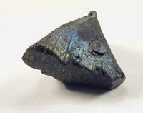 Discovery Information Discovery Information
|
| Who: Eugene Demarcay |
| When: 1901 |
| Where: France |
|
 Name Origin Name Origin
|
| From Europe. |
| "Europium" in different languages. |
|
 Sources Sources
|
| It is never found in nature as a free element. There are many minerals that contain europium, the important of these are bastnasite
and monazite.
|
| Primary mining locations are the USA, Brazil, India, Sri Lanka, Australia and China. Annual production is around 400 tons. |
|
 Abundance Abundance
|
| Universe: 0.0005 ppm (by weight) |
| Sun: 0.0005 ppm (by weight) |
| Carbonaceous meteorite: 0.006 ppm |
| Earth's Crust: 2.1 ppm |
| Seawater: |
| Atlantic surface: 9 x 10-8 ppm
|
| Atlantic deep: 1.5 x 10-7 ppm
|
| Pacific surface: 1 x 10-7 ppm
|
| Pacific deep: 2.7 x 10-7 ppm
|
|
 Uses Uses
|
| Europium oxide (Eu2O3) along with yttrium oxide are used to make red phosphors for colour televisions. A salt of Europium is a component of the newer phosphorescent
powders and paints, some of which will glow for days after a few minutes of exposure to light.
|
| A salt of Europium is a component of the newer phosphorescent powders and paints, some of which will glow for days after a
few minutes of exposure to light. Europium fluorescence is used to interogate biomolecular interactions in drug-discovery
screens. It is also used in the anti-counterfeiting phosphors in Euro banknotes.
|
|
 History History
|
| Europium was first found by Paul Emile Lecoq de Boisbaudran in 1890, who obtained basic fraction from samarium-gadolinium concentrates which had spectral lines not accounted for by samarium or gadolinium; however, the discovery of europium is
generally credited to French chemist Eugene-Anatole Demarcay, who suspected samples of the recently discovered element samarium
were contaminated with an unknown element in 1896 and who was able to isolate europium in 1901. When the europium-doped yttrium
orthovanadate red phosphor was discovered in the early 1960s, and understood to be about to cause a revolution in the colour
television industry, there was a mad scramble for the limited supply of europium on hand among the monazite processors. (Typical
europium content in monazite was about 0.05%.) Luckily, Molycorp, with its bastnaesite deposit at Mountain Pass California,
whose lanthanoids had an unusually "rich" europium content of 0.1%, was about to come on-line and provide sufficient europium to sustain the
industry. Prior to europium, the colour-TV red phosphor was very weak, and the other phosphor colours had to be muted, to
maintain colour balance. With the brilliant red europium phosphor, it was no longer necessary to mute the other colours, and
a much brighter colour TV picture was the result. Europium has continued in use in the TV industry ever since, and, of course,
also in computer monitors. California bastnaesite now faces stiff competition from Bayan Obo, China, with an even "richer" europium content of 0.2%. Frank Spedding, celebrated for his development of the ion-exchannge technology
that revolutionized the rare earth industry in the mid-1950's once related the story of how, in the 1930's, he was lecturing
on the rare earths when an elderly gentleman approached him with an offer of a gift of several pounds of europium oxide. This
was an unheard-of quantity at the time, and Spedding did not take the man seriously. However, a package duly arrived in the
mail, containing several pounds of genuine europium oxide. The elderly gentleman had turned out to be the Dr. McCoy who had
developed a famous method of europium purification involving redox chemistry.
|
|
 Notes Notes
|
| Europium is the most reactive of the rare earth elements; it quickly oxidizes in air, and resembles calcium in its reaction with water. It is about as hard as lead and quite ductile.
|
|
 Hazards Hazards
|
| As dust, europium presents a fire and explosion hazard. |





 Discovery Information
Discovery Information
 Name Origin
Name Origin
 Sources
Sources
 Abundance
Abundance
 Uses
Uses
 History
History
 Notes
Notes
 Hazards
Hazards
 Images
Images
